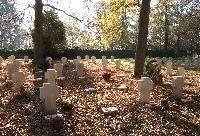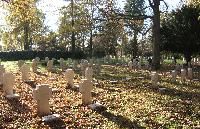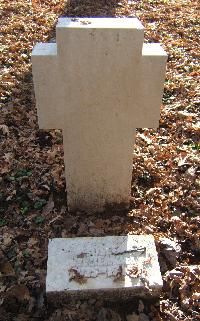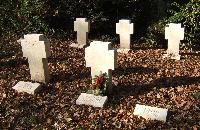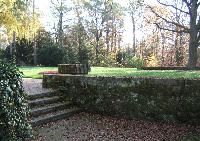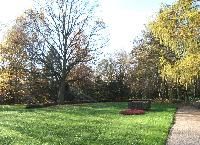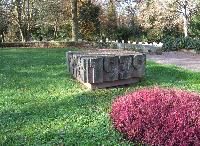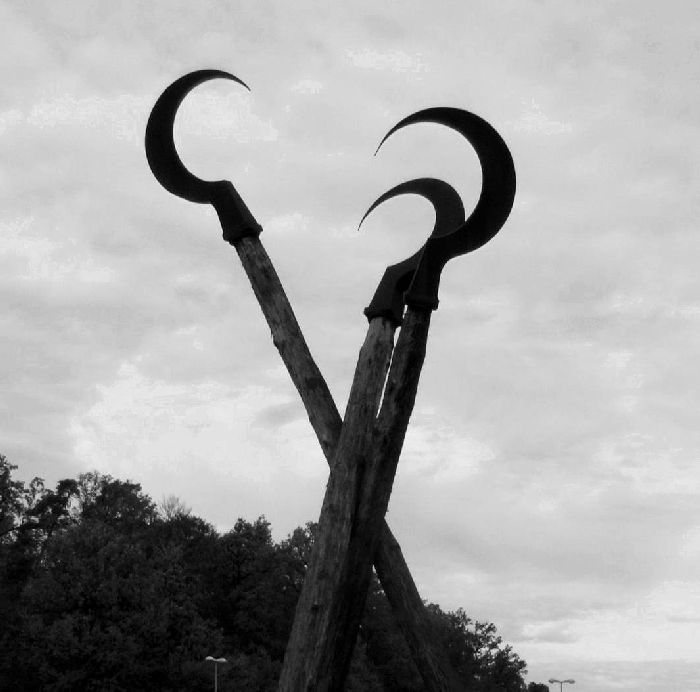These pictures were taken on 8 November, 2005 at the Waldfriedhof in Stuttgart,
Germany. It was a beautiful late morning, so the sunlight and long autumn shadows and
colors both helped and hindered the work. A professional photographer could have
done wonders with a day like that. I ended up with some good shots, but some over-exposed
ones as well.
The military graveyards occupy the center of the cemetery, first with an opulent
ensemble for the dead of the First World War, then a smaller and more sober section
for the Second World War. Both are located very near the
sections for the victims of the airraids of 1918 and 1944. The
cemetery was opened shorty before World War One, so there are no markers for earlier
events such as the Franco-Prussian War.
The two sections for the two world wars will be shown and discussed separately below.
But there is much to learn by comparing the two. They stand adjacent to each other, and
yet are full of contrasts. For one thing, there are several times as many
graves for the First World War than for the Second. I assume that has to do with
the relative importance of Stuttgart as a hospital site. During World War One it was
relatively close to the front for a prolonged period of time. Many who survived their
wounds long enough to be evacuated to Stuttgart would have died and been buried here.
As in other locations, the graves are not likely to be of those who are from Stuttgart.
Germany did not invest the logistical effort into revacuating every body back to its
home town. They are those who died in or near Stuttgart.
At the center of the World War One memorial is an ensemble that is hard to capture in
one main photograph. It consists of two main halves, facing each other. One half is an
altar-like assembly. The other half features the statue of a woman.

|
When coming from the cemetery entrance, along the left is a wall with a set back
terrace, much like an altar, and a large cross.
|
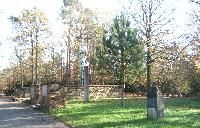
|
Here is the same half of the ensemble, viewed from the other side, facing the cemetery
entrace.
|
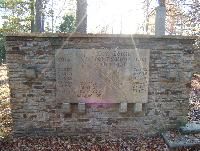
|
There are nine large plaques along the wall. The four on the front, along the walkway
are dedicated to military units. This first one, on the far left, reads, For the dead of the 7th Landwehr
Division. It then lists member regiments and locations fought.
|
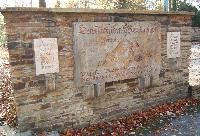
|
The second one reads, For the dead of the 26th Reserve Division followed by the
word Fearless and then, further down, and loyal. This one appears to be
damaged. It also lists locations fought. Member regiments are listed on the two white
side plaques.
|
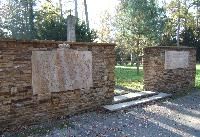
|
On the other side of the altar, two plaques similarly recognize other divisions.
|
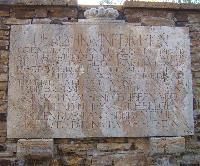
|
The first is for the 26th 1st Royal Württemberg Infantry Division. 17,000 were killed in
France, Belgium, Poland, Russia, Serbia, and Italy.
|
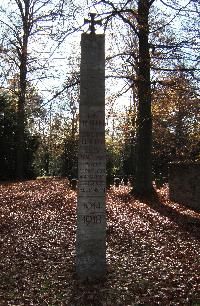
|
Behind the wall bearing these front plaques, to the sides of the terrace/altar, there are
two obelisks also dedicated to units. This is the one on the left, dedicated to the 2nd
Württemberg Landwehr division. It also lists member regiments and locations the
division fought in.
|
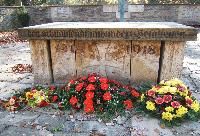
|
The centerpiece of this part of the ensemble is this altar, here still decorated with
flowers from All Saints' Day. The wording is hard to translate piece by piece,
going around the altar. As a whole it reads, In memory of the 8,500 fallen as a
declaration of loyalty from the citizens of the city of Stuttgart.
|
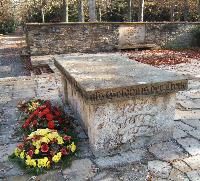
|
Here is the right side.
|
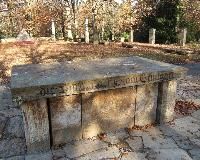
|
Here is the back.
|
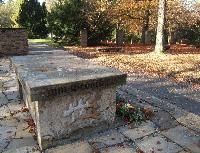
|
Here is the left side. The three antlars are on the royal coat of arms of Württemberg, of
which Stuttgart is the traditional capital.
|
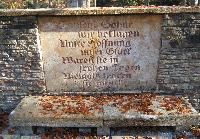
|
Behind the altar, along the wall surrounding the terrace, there are four more large
plaques. The one on the left, shown here, reads, A thousand sons we mourn / Our hope
and our joy / They were in happy days / They will never return.
|
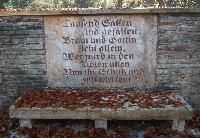
|
The next reads A thousand husbands have fallen / The bride and wife is now alone /
Who will in times of need / Be her defense and refuge?
|
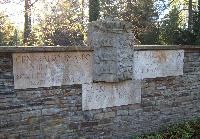
|
Continuing around the terrace, in the middle, directly behind the altar and below the
cross, there is this piece dedicated to the corps troops, corps administration, and
the Army Group of Duke Albrecht.
|
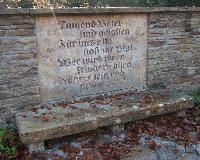
|
Then, now on the right, there is this plaque: A thousand fathers fell / For us all
their blood flowed / Who will for their children / be leader and protector?
|
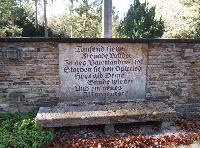
|
Finally, this one reads A thousand beloved friends and brothers / In Fatherland's time
of need / Died the death of sacrifice / Lord give your grace again / and a new dawn.
|
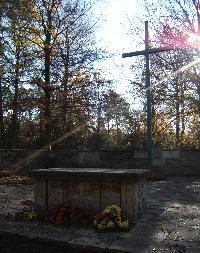
|
Here is another shot of the altar and cross.
|
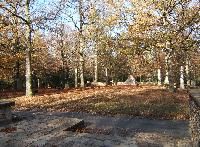
|
Standing on the terrace, the other half of the ensemble, with the woman figure, looks
like this.
|
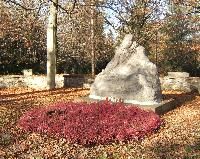
|
Here she is up close. There are still candles from All Saints' Day. Her base has been
recently renovated.
|
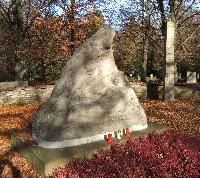
|
Another shot of her. There is a small wall that runs in a semicircle around behind her.
To her left and right, and then continuing on behind the wall, there are standing memorials
to particular types of units.
|
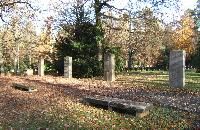
|
Here are four of them lined up to her right.
|
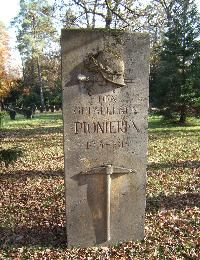
|
This on is for fallen combat engineers.
|
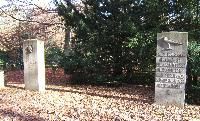
|
This one, with a bird, is In honorable memory of Württemberg pilots, airshipmen and
anti-aircraft troops.
|
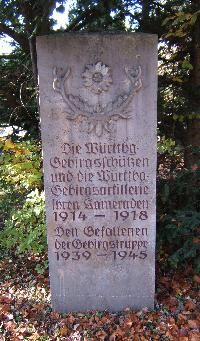
|
One of them to the left was dedicated to the mountain infantry and mountain artillery
of Württemberg. After the Second World War, it was "updated" to include the
later conflict as well. As we will see below, unit-specific memorials were not to be
part of the World War Two ensemble.
|
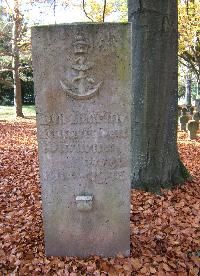
|
This one is for naval personnel.
|
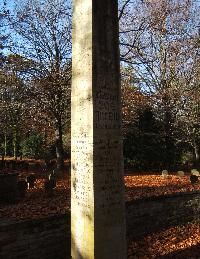
|
Arranged to the right and left of the woman there are four more obelisks which, like the
ones to the sides of the altar, are dedicated to entire divisions. Their component
regiments and places they fought are listed. This one to the left is for the 204th
infantry division.
|
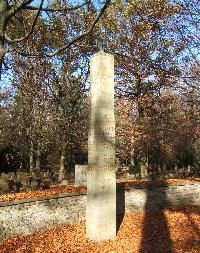
|
This one, also on her left, is for the 260th infantry division.
|
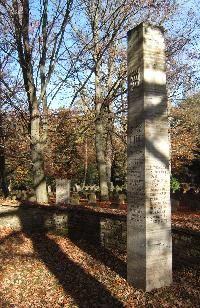
|
This one on the right is for the 27th Infantry Division. Note the
antlars, the emblem of Württemberg, near the top.
|
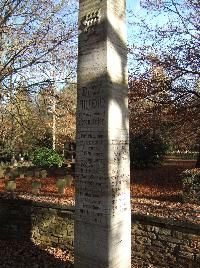
|
Here is a closer view. |
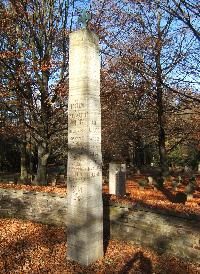
|
This one is for the 243rd Division.
|
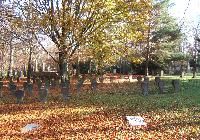
|
Surrounding this center ensemble are rows and rows of graves of individual soldiers.
Behind the altar, they are in straight rows.
|
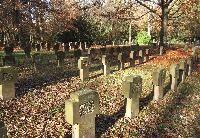
|
Behind the mourning woman, they go out in concentric circles.
|
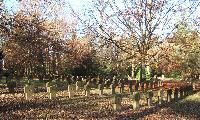
|
.
|
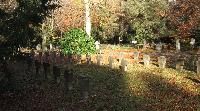
|
.
|
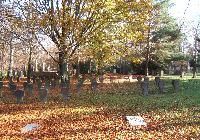
|
Here is a view of the center in the distance. The altar ensemble is visible behind the
tree on the right, the woman figure to the left. |
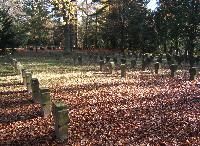
|
.
|
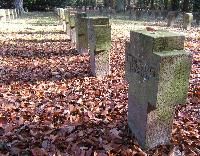
|
Each cross lists the name and the years of birth and death of one soldier.
|
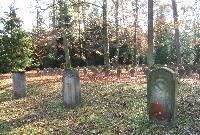
|
Along the walkways, in front of many of the grave sections, there
are graves to individuals, usually officers.
|
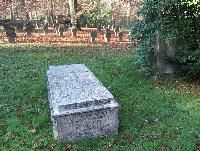
|
.
|
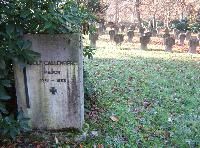
|
.
|
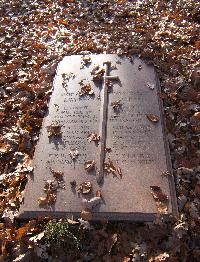
|
Some of these markers in front were flat on the ground or slightly raised, as if to
suggest a coffin. This marker is for two men, apparently brothers. The one on the left
died in Stuttgart in an airplane accident, the other died of his wounds.
|
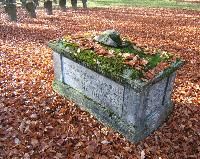
|
This man was a 1st lt. with Lettow Vorbeck's troops in German East Africa. He died in 1921.
|
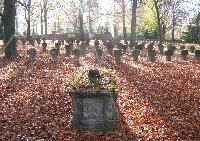
|
Here is another shot. The woman figure is visible in the background.
|
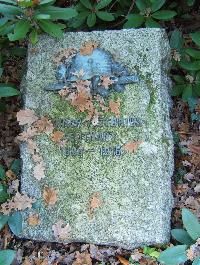
|
Some show the steel helmut motif. This helmut came into use in 1916.
|
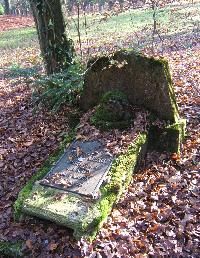
|
This steel helmut is totally overgrown with moss.
|
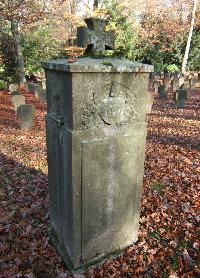
|
I only found one with the 1914-1915 style Pickelhaube helmut.
|
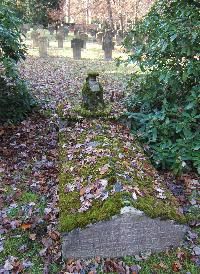
|
The "classical" Greco-Roman style helmut was also used on some of these individual markers.
|
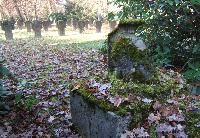
|
.
|
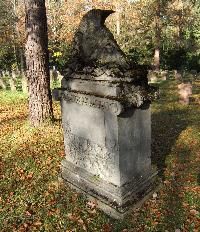
|
This one is near the central ensemble and is dedicated to two men, probably brothers.
While one died on the western front in 1918, the other died in 1921 in Silesia. This is
the only memorial to the Freikorps combats I have yet to see in Germany.
|
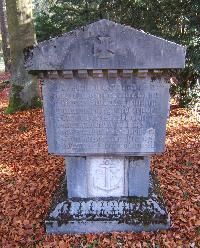
|
This one is dedicated to my only dearly beloved son who died of his wounds in 1915.
|
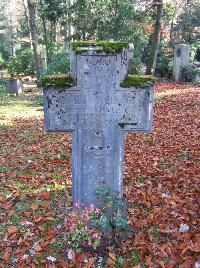
|
This flat, standing cross is a common model.
|

|
.
|
The World War Two ensemble totally lacks the pageantry, pomposity, explicit
theology and symbolic glorification of the World War One site. It is a simple
arrangement, a place of few words, probably intended for quiet contemplation.




















































